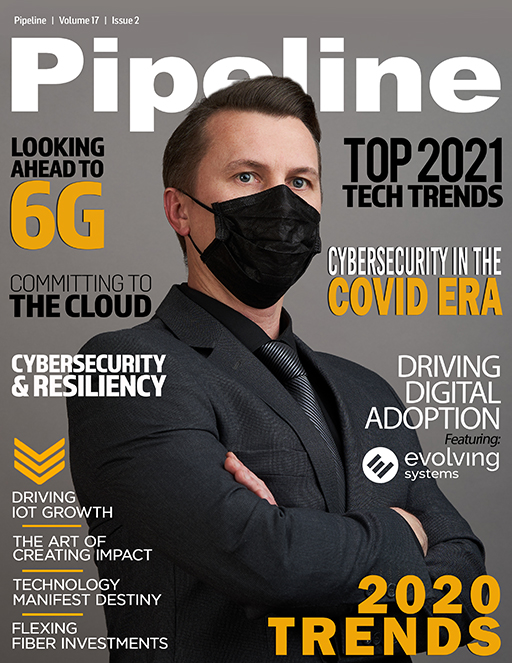By: Nick Maynard
Every year, we analyze and forecast many markets. As a result of this year’s analysis, we can therefore discuss three important technology trends that will grow in strength in 2021. Growth in
A2P Messaging A2P (Application to Person) messaging refers to the sending of mobile messages from a software application, run by an enterprise, to a consumer’s device. Users must opt in to receive
mobile messages from applications, enabling them to interact with enterprises through a mobile network connection…
» read this article
By: Adrian Scrase
While 5G rolls out, the research community is already thinking about its successor. The technological goals for 6G are ambitious, with huge advances in speed and capacity matched by tough
requirements for reliability, security and energy efficiency that will benefit a wide range of industrial applications. As with previous generations, the key to a thriving 6G ecosystem will be
unified technical standards that accelerate commercial returns on billions of dollars of R&D investment. As a rule of thumb, we’ve grown accustomed to a roughly ten-year gap between the arrival
of successive mobile generations…
» read this article
By: Paul Caiazzo, Corey McReynolds
For most of 2020, shelter-in-place and COVID-19 public health and safety guidelines have kept many US workers remote. This reality has strained organizations that were unprepared for this rapid
shift. For instance, existing virtual private network (VPN) infrastructure was designed to support less than 30 percent of the workforce at any given time, rather than the 90 to 100 percent using
it during the outbreak. The new threats associated with a mostly or fully remote workforce increase the probability that an organization will experience a data breach or other cybersecurity
incident…
» read this article
By: Eric Troup
The COVID-19 pandemic made clear the advantages of truly committing to the cloud and embracing operating as a cloud-based digital-native business. Businesses felt the strains brought on by
dramatic unexpected shifts in process patterns and volumes across their entire organizations. Some workloads contracted, while many other workloads expanded dramatically or changed their patterns
beyond all projections. Modeling and forecasting became difficult. Organizations that could theoretically operate remotely or virtually during the pandemic but that were not truly prepared to
do so struggled to keep up with a rapidly changing environment…
» read this article
By: Kerry Singleton
Soon after the World Health Organization (WHO) declared Covid-19 a pandemic, consumers and businesses realized that digital is the key to the future. Today people shop online, pay via mobile
devices and—because they work remotely—access many apps that enable them to collaborate, innovate, and remain productive. According to a recent study, global Internet disruptions saw an
unprecedented, dramatic rise in March, coinciding with pandemic-related shelter-in-place orders. These remained elevated through the first half of 2020 compared to pre-pandemic levels…
» read this article
By: Xabier Miqueo
Over the past year or two, we’ve all heard an almost endless amount of chatter (think media articles, analyst presentations, vendor blogs, and expert briefings) about 5G, innovative digital
services, big data, digitization, and the incoming network revolution. That’s the digital network to you and me. This is all well and good, but let’s consider the possibility that this
next-generation telecom world could end up being all sound and fury, but actually signify nothing. What if I pull out my nifty, does-everything-you-could-possibly-imagine iPhone 13 (yes, I know,
but let’s pretend it’s already here), it latches onto my service provider’s 5G network; and…I call my mum…
» read this article
By: Ben Pietrabella
5G and the Internet of Things (IoT) will completely revolutionize our lives in the coming years. According to a recent study from Juniper Research, industrial IoT connections are projected to
jump from 17.7 billion in 2020 to 36.8 billion in 2025. Along with connectivity, the number of IoT devices is poised to grow massively. According to data gathered by Statista, the number of IoT
devices is expected to more than double to 21.5 billion in the next five years. While 5G is currently being introduced, there’s been plenty of bandwidth available within 4G and Wi-Fi technology to
keep rolling out devices…
» read this article
By: Ulla Koivukoski
The global ecosystem game is on. The players are diverse. They come from different national and organizational cultures. Their positions are sometimes well-defined, but more often not. The
impact created by ecosystems is strongly dependent on the collaborative capabilities of the people of the participating partners. The key question for success is: “How do we best use the
superpowers of the organizations and their people?” Understanding ecosystems: Defining the playing field When ecosystems work, they create value that no single organization could create
alone…
» read this article
By: Mark Cummings, Ph.D.
To manage their destiny, CSPs need to become intelligent consumers of infrastructure software. As telcos and other communications service providers move into software-centric networks, they
face a key decision. Some are focused on buying all their key software from one or two large vendors. Others are choosing to focus on developing their own key software internally. Both of these
approaches are fraught with danger, including the concerns of innovation, differentiation, reskilling, and cost control…
» read this article
By: David Stokes
Every telecoms network in the world is a web of different coexisting communications technologies—from copper wire to fiber optic, cellular to microwave, and millimeter wave to satellite. These
networks deliver a host of service types to consumers and businesses as well as underpin critical national infrastructure, emergency services and the developing Internet of Things. This article
shines a light on the unheralded transport network—and what the future demands of it. Despite how the network is accessed, it falls to the transport network to manage all the traffic and ensure it
is carried effectively and efficiently to the right destination…
» read this article
By: Scott St. John - Pipeline
On Tuesday, December 8th, 2020 Margaret Keenan of Britain became the first person in the world to receive the Pfizer-BioNtech COVID-19 vaccine outside of clinical
trials. This is the end, or at least the beginning of the end, of a very long and arduous journey. If nothing else, this marks a new beginning, with tens of millions of vaccine doses of the
Pfizer-BioNtech vaccine becoming publicly available right away, multitudes more to follow as production continues to increase, and a half-dozen other vaccines come to market beyond that…
» read this article
By: Scott St. John - Pipeline
What a year 2020 has been, challenging us in many ways while advancing us in others. In this final issue of Telecom Industry News for the calendar year, we offer some of the top headlines of
the month and the top trends of 2020. Worldwide, 5G deployments, advancements and milestones made news. Studies captured the increasing shift of our lives online, as we work, learn, spend and
purchase in new ways and demand (and expect) more from our digital connections with and to each other. The top telecom industry news stories from the month are summarized below…
» read this article

















